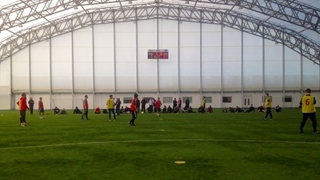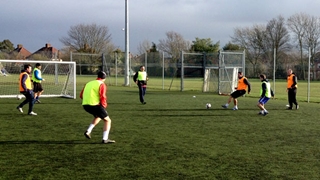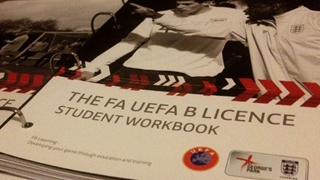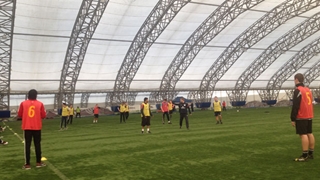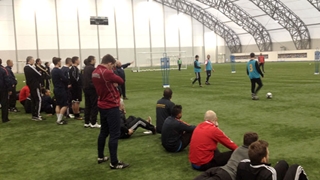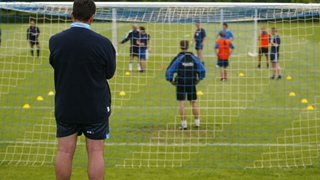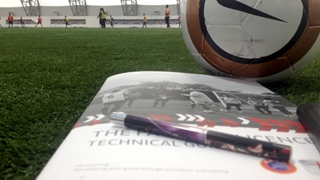
FA Editor Jamie Bradbury has taken his next steps along the coaching pathway and is now working towards the UEFA B coaching licence.
The first day back for the second week block looked at player and team analysis...
A month after we were last together we reconvened at the London Soccerdome in Docklands for day six of the course - the first of our second week block.
It was good to catch up with everyone again. There are 48 of us on the course, split into four smaller groups of 12, each with a tutor to help us. Course Director Jon Gittens originally took our group on, but began day six by introducing us to another tutor, Ed McCluskey, who would take over from him so he could oversee the wider group.
Much of the morning was in the classroom as we had a re-cap of the first week and took a look at two of the assignments in our student packs - all 12 assignments need to be completed before we can take our final practical assessment in September.
That sounds pretty straightforward, and will be with the appropriate time and commitment dedicated to them. However, while some of the assignments are covered in the classroom, there are others that can only be done back at our clubs.
And assignments five and seven are two in particular that require a lot of consideration and highlight just why you need to be coaching regularly in an appropriate environment.
They look at player analysis, player performance and fitness analysis. Richard Carter (tutor) led the discussion about the different types of analysis - quantitative (data) and qualitative (video) - and also explained the four-stage analysis continuum.
Analysis Continuum
- Stage 1: Observe
- Stage 2: Decide which player to focus on
- Stage 3: Gather data and present to player
- Stage 4: Plan related sessions, analyse and review
We talked about the need for performance analysis and, having worked for the last eight years inside various England teams, I've seen the level of detail that elite coaches go to to analyse their own team as well as the opposition.
Some of the things mentioned were that teams can understand their strengths and weaknesses, understand progress and development of players, highlight improvements for individuals or the team and to set goals and targets.
Richard put on a DVD from a recent England match and we had a go at analysing players from a data perspective. Our group had to follow Gareth Barry and note how many times he won a tackle or interception and how many times he travelled with the ball.
Our task away from the course will be much more in-depth; we must watch at least three or our team's games and review the performance of two players during each of the match using the templates in our packs. Once all three games have been analysed, we must select one of the players to work with to enhance their performance by means of three planned coaching sessions.
Finally, we must watch three more games to see if the player has improved in the areas we focused on. And that's all just for assignment five.
The other theory sessions on day six were with tutor Ted Dale, looking at attacking set-plays, and with Ed, looking at developing play in the attacking thirds. We watched another DVD with a series of clips featuring free-kicks, corners and teams on the attack and then, in groups of six, we had to come up with our own free-kick to share with the group.
There were some simple ones and some not so simple ones, and the tutors voted on which they thought was the best. They weren't overly keen with ours, and even I was a little confused by it, but we didn't try any out so it was hard to really see which one of the most creative.
What we were able to try, though, were the two practical sessions of the day, and I've drawn up one of them using The FA Coach's App. They were;
Central Midfield Receive and Distribute
Advanced Technical Practice, progressing to a Small-Sided Game
Colin Reid (tutor) began by outlining the session and highlighted keys areas we need to consider when planning a session; organisation, management, observation diagnosis, communication styles. At the start he encouraged free play to check the players' understanding and whether players suit. He said that we shouldn't be worried about changing things if it's not panning out.
Ted then took over and went into a bit more detail about the coaching styles and which ones might be more suited to UEFA B sessions compared to Youth Module sessions, for example. He also showed as an interesting diagram to help us consider where to start practices so we bring realism into the session and meet the objectives of the topic [see image below]
Forward Movement and Finishing
Advanced Technical Practice, progressing to a Squad Practice - click to download pdf created with The FA Coach's App
Richard started with an advanced technical practice and talked about technical details of the attacking session. Forwards 'pinning' mannequins to open up spaces for passes from midfield, second striker working as a foil and sniffing for rebounds, midfielders to pass in forward but away from their body and shooting across goal were some key things touched upon.
On our return to the classroom to wrap up the day's activities, Jon distributed our topics for the second practical session we must deliver. I was given a Phase of Play: Coach a team to defend in it's own half of the field.
We each have a 25-minute slot this week to put on our practice, so on the way home I got started on the planning. First thing to consider - principles of defending...
Keep checking TheFA.com for more from the UEFA B course. If you have any questions you can follow Jamie on Twitter @jamiebradbury.
To find out more about local coaching courses, visit your County FA website, or for national courses click here.






